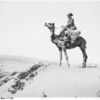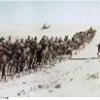The Imperial Camel Corps/Heat, Desert and Water
The Imperial Camel Corps was created in 1916 and attached to the Egyptian Expeditionary Force. The first units were formed from Australians returning from Gallipoli using camels from the Indian state of Bikaner (later replaced by Egyptian camels). The camels were ideal in the hot, dry deserts of Libya, Egypt and Sinai and they were crucial early in the Sinai and Palestine Campaign, and fighting against, or supporting, uprising inside and outside the Turkish Empire.
The Corps was initially used for patrolling the desert, but it was soon used in combat operations. Their first action was against the Senussi, a religious sect based in Libya and parts of Egypt. Turkey and Germany convinced the Senussi to raid British forces to distract them from the impending assault on the Suez Canal. The Senussi were battle-hardened, having been engaged in a war with Italy (which held Libya). Britain and Italy continued to fight against the Senussi until 1917.
The Camel Corps also assisted in the Arab Revolt. Britain and France also fomented rebellion from within the Turkish Empire, just as Turkey and Germany did without. The Arab revolt was a campaign against the Turkish Empire led by Hussein bin Ali, Sharif of Mecca. Although the revolt did not become widespread throughout the Arab tribes, the British and French continued to support it until the war against Turkey ended in 1918. The revolt is most famously associated with TE Lawrence or ‘Lawrence of Arabia’. Lawrence was only one of numerous British and French officers that contributed to the revolt, but he became the most famous, especially because of his depiction in David Lean’s epic film, Lawrence of Arabia (1962). The Camel Corps fought with the Arabs in 1918.
In the wider theatre, the Camel Corps ceased to be useful as the Expeditionary Force entered Palestine because the terrain no longer favoured camels. The Corps was disbanded towards the end of the war with Turkey.

Depicts the Camel Corp ‘Cameliers’ at the point where they were dismounting to advance on foot at Magdhaba. The Imperial Camel Corps Brigade was raised from the Australian, New Zealand and British Armies; of its four Battalions, two and a half were Australian. On 23 December 1916, in company with the Anzac Mounted Division under Major General Henry George Chauvel, the Brigade took part in the attack on a strong Turkish post at Magdhaba in Sinai. After a night march of 80km they surprised and surrounded the Turks who were over run after a hard fight (ART09230 and text courtesy of the Australian War Memorial).

An Australian officer of the Imperial Camel Corps, on a camel in the desert (B01479 and text courtesy of the Australian War Memorial).

Australians of the Imperial Camel Corps (P03631.007 and text courtesy of the Australian War Memorial).
Did you know……
Water, heat and deserts were key factors in the Middle East theatre. This made it especially distinct from the Western Front, which was characterised by mud and rain.
Throughout the entire war the presence or absence of water defined when and where armies could strike and if they could hold a position once captured. Operations in the Sinai, for example, relied on possession of oases (springs of water in the desert) or denying them to the enemy. Faced with three possible routes Turkish forces could take to reach Romani in the Sinai, the British cut two off by draining all oases and capping them, funnelling the Turkish along the route preferred by the British. The British could not contemplate attacking Gaza until they had built a water pipeline all the way from the Suez Canal!
Australian ingenuity led to the invention of the Spear Point by an Army Engineer that helped Australian Forces get water from the desert in more places and more efficiently, which extended the range of patrols and other military operations.

